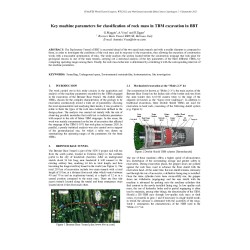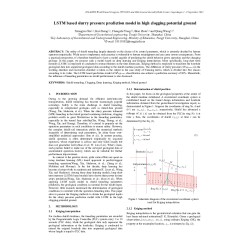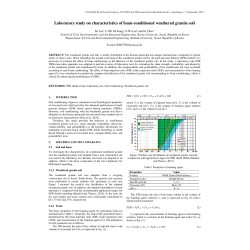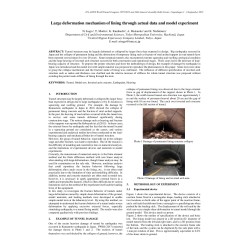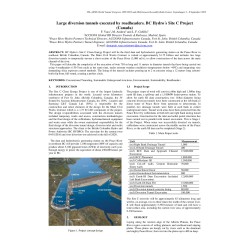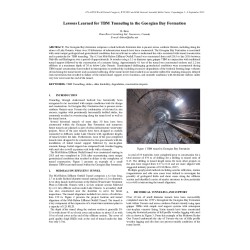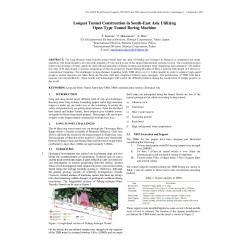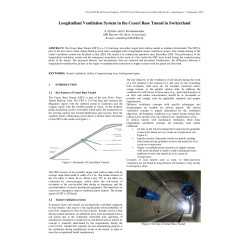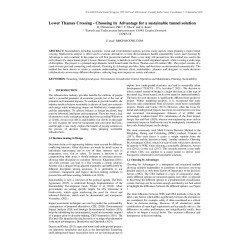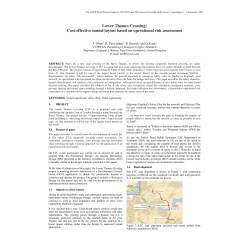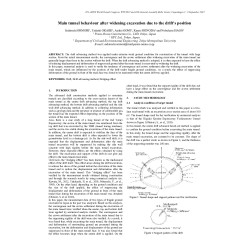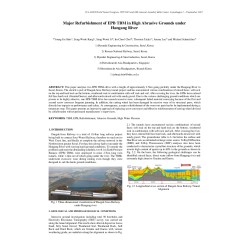No document
Search & filter
Search for a publication
Search & filter
World Tunnelling Congress
WTCThere are 1984 documents.
-
Key machine parameters for classification of rock mass in TBM excavation in BBT
Abstract: The Exploratory Tunnel of BBT is excavated ahead of the two equal main tunnels and with a smaller diameter as compared to them, in order to investigate the conditions of the rock mass and its response to the excavation, thus allowing the execution of construction works with a reasonable optimization of risks. The study analyses the section located before the construction stoppage that took...
0,00 € -
Koralmtunnel - Health and Safety during Construction since the very beginning
Abstract: ABSTRACT: The 33km long Koralmtunnel is the heart of the Koralm Railway between Styria and Carinthia in Austria. The first design works for this project started in the 1990s, the tunnel construction works began in 2008 and today the works for the railway fit-out as well as the technical equipment and systems have commenced. Health and safety played an important role during the design process....
0,00 € -
LCC as an Economic Valuation Approach for Underground Light R ail systems
Abstract: Urban public transport with underground light rail systems requires a costly transport infrastructure. For this purpose, life cycle costing (LCC) is a useful economic evaluation tool for determining and optimizing the initial and follow-up costs of subway light rail systems over their lifetime and thus also for organizing the maintenance intervals of subway stations, tunnel facilities and...
0,00 € -
LSTM based slurry pressure prediction model in high clogging potential ground
Abstract: The safety of shield tunneling largely depends on the choice of its control parameter, which is currently decided by human operators empirically. While easy to implement, such practice is vulnerable to human misjudgment and can cause severe consequences. From a practical perspective, it’s therefore beneficial to have a model capable of predicting the shield behavior given operation and the...
0,00 € -
Laboratory Study on Characteristics of Foam - Conditioned Weathered Granite Soil
Abstract: The weathered granite soil that is widely distributed in the Korean peninsula has unique characteristics compared to typical sandy or clayey soils. When tunnelling the ground consisting of the weathered granite soil by the earth pressure balance (EPB) shields, it is necessary to evaluate the effect of foam conditioning on the behavior of the weathered granite soil. In this study, a...
0,00 € -
Large deformation mechanism of lining through actual data and model experiment
Abstract: Tunnel structure may be largely deformed or collapsed by larger force than expected in design. Big earthquake occurred in Japan and the collapse of permanent lining and the destruction of temporary lining such as fracture of steel arched support in road tunnels have been reported several times for over 20 years. Some mountain tunnels also encountered extreme squeezing and swelling geological...
0,00 € -
Large diversion tunnels executed by roadheaders. BCHydro´s Site C Project
Abstract: BC Hydro’s Site C Clean Energy Project will be the third dam and hydroelectric generating station on the Peace River in northeast British Columbia, Canada. The Main Civil Works Contract is valued at approximately $1.75 billion and includes two large diversion tunnels to temporarily reroute a short section of the Peace River (3,000 m3/s), to allow construction of the dam across the main channel...
0,00 € -
Lesson Learned During the EPB TBM Launch Using Umbilical and Muck Pump
Abstract: The launch of a Tunnel Boring Machine (TBM) is one of the most challenging activity parts of the construction of a tunnel. Challenges are coming from limited space available, learning curve, concurrence of other activities and in some cases from the geological conditions. Launching a TBM is an extraordinary and complicated operation requiring a great level of planning. The Earth Pressure...
0,00 € -
Lessons Learned for TBM Tunneling in the Georgian Bay Formation
Abstract: The Georgian Bay formation comprises a shale bedrock formation that is present across southern Ontario, including along the shores of Lake Ontario, where over 30 kilometers of infrastructure tunnels have been constructed. The Georgian Bay Formation is associated with some unique geological and geotechnical conditions that are relevant in order to understand the risks associated with tunnel...
0,00 € -
Long -term field measurements on seasonal behavior of shield tunnel lining
Abstract: Many shield tunnels have been constructed in urban areas in many countries. They should be maintained properly to confirm the structural stability and to secure the users’ safety. Cracks on secondary lining or water leakage between segmental joints are frequentlyfound defects. Width of cracks and joint opening are typically affected by seasonal temperature change. Periodicity of the width is...
0,00 € -
Longest Tunnel Construction in South-east Asia Utilizing
Abstract: The long-distance water transfer tunnel which links the state of Pahang and Selangor in Malaysia is completed and under operation. The tunnel length is 44.6 km with diameter of 5.2m and it is one of the largest infrastructure projects in Asia. The completed project relieves the shortage of water supply for daily life and industries of Kuala Lumpur and Selangor State (Supplying Approximately...
0,00 € -
Longitudinal Ventilation System in the Ceneri Base Tunnel in Switzerland
Abstract: The Ceneri Base Tunnel (CBT) is a 15.4 km long, twin-tube, single-track railway tunnel in southern Switzerland. The CBT is part of the new Swiss Trans-Alpine Railway Link and is equipped with a longitudinal tunnel ventilation system. The commissioning of the tunnel ventilation system was finalized in July 2020. The tunnel is in commercial operation since December 2020. The performance of the...
0,00 € -
Lower Thames Crossing - Choosing by Advantage for a Sustainable Tunnel Solution
Abstract: Sustainability including economic, social and environmental aspects, governs many aspects when planning a major tunnel crossing. Multicriteria analysis is often used to evaluate alternatives to help decisionmakers handle sustainability issues and Choosing by Advantage is such a method. In this paper we will first present the method. Then a case study will present how this method was used in the...
0,00 € -
Lower Thames Crossing – Cost-effective Tunnel Layout Based on Operational Risk Assessment
Abstract: Plans for a new road crossing of the River Thames, to relieve the existing congested Dartford crossing, are under development. The Lower Thames Crossing (LTC) is a proposed new road connecting the counties East of London through a tunnel beneath the River Thames. The project consists of approximately 23km of new roads including a 3.9km long twin-bored tunnel with 3 lanes in each bore. At 16m...
0,00 € -
Main tunnel behaviour after widening excavation due to the drift's position
Abstract: The drift advancing method was applied under extreme weak ground condition for construction of the tunnel with large section. From the actual measurement results, the convergence and the crown settlement after widening excavation of the main tunnel are generally larger than those in the section without the drift. When the drift advancing method is adopted, it is often expected to have the...
0,00 € -
Major Refurbishment of EPB TBM in High Abrasive Grounds under
Abstract: This paper analyzes two EPB TBMs drive with a length of approximately 2.7km going partially under the Hangang River in Seoul, Korea. The stretch is part of Daegok-Sosa Railway tunnel project and has encountered various combinations of mixed faces: soft rock on the top and hard rock on the bottom, weathered rock in combination with soft rock and soil. After crossing the river, the EPBs have...
0,00 €

